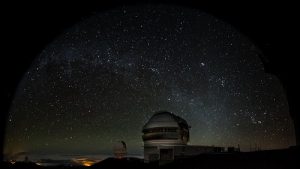Hawaiʻi Telescopes Discover Origins of ‘Blue Binary Planetoids’

Artist’s conception of a loosely tethered binary planetoid pair like those studied by Fraser et al. in this work which led to the conclusion that Neptune’s shepherding of them to the Kuiper Belt as gradual and gentle in nature. Credit: Gemini Observatoryy/AURA, artwork by Joy Pollard.
A team of researchers have made a new discovery using data gathered by Gemini Telescope and Canada-France Hawaii Telescope on Maunakea revealing how distant planetoids arrived in the outer reaches of the Kuiper Belt.
The Kuiper Belt consists of a massive swarm of icy, small planetoids on the outskirts of our Solar System. Much of these far-flung inhabitants are known as red Cold Classical Kuiper Belt Objects (CCKBO), which are thought to have formed where they currently orbit during the early stages of the Solar System.
But some celestial objects in this outer belt are oddball objects known as “blue binaries,” owing to their cooler color. Scientists have theorized that these loosely bound pairs of blue planetoids arrived in the outer reaches of the Solar System through the force of Neptune’s gravitational pull.
This migration is thought to have happened several billion years ago during profound changes to the orbits of Jupiter, Saturn, Uranus and Neptune.
Data used in the study was collected between both Gemini Telescope and Canada-France Hawaii Telescope, working in a significant coordinated effort to capture light traveling billions of miles through our Solar System. They were published in the April 4 issue of the journal Nature Astronomy.

The Gemini North telescope (foreground, right) with the Canada-France-Hawaii Telescope in background (left). Image obtained during observations for Col-OSSOS and both telescopes are pointing at the same target.Credit: Gemini Observatory/AURA, photo by Joy Pollard.
The research team, led by Wes Fraser of Queen’s University in Belfast, UK, measured data collected from both telescopes that revealed the colors of peculiar new CCKBO pairs as part of the Colours of the Outer Solar System Origins Survey (Col-OSSOS).
Fraser found that although these blue binaries have a very subtle gravitational bond, they could be influenced by Neptune’s gravitational force over a distance of at least four AU (four times the distance between the Earth and Sun).
Coauthor of the study and Gemini Astronomer Megan Schwamb said these objects give us a unique window into the ancient history of our Solar System, offering fossils from eons beyond human history.
“This research has opened the window to new aspects of understanding the early stages of planet growth,” added Fraser. “We now have a solid handle on how and where these blue binaries originated.”













